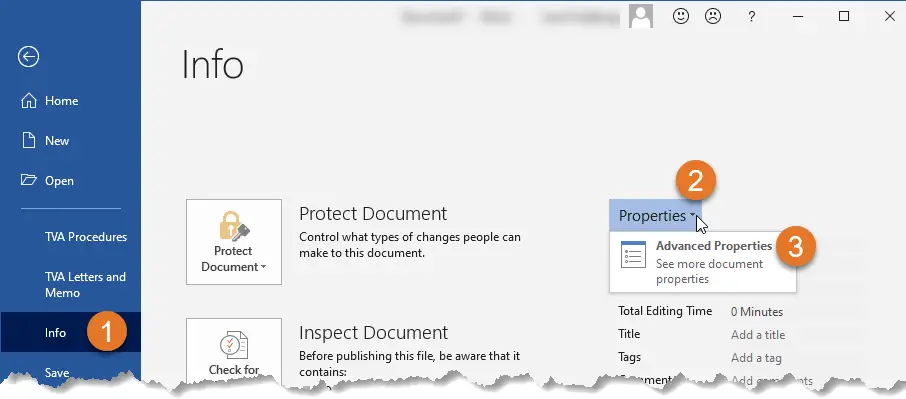How properties and DocProperty fields work
Learn what document properties in Microsoft Word can be used for. How to add document properties in Word, how to edit and insert document properties, etc.
When used wisely, document properties and DocProperty fields can help you produce better Word documents in less time.
In this article, you will learn what a document property is and what a DocProperty field is. You will learn where to find the Advanced Properties in Word. The article explains how you can use the built-in functionality of Word to add or edit document properties and insert DocProperty fields, both via the general user interface and via macros (VBA).
The general information below about Microsoft Word document properties and DocProperty fields apply to both custom document properties and DocProperty fields you create using Word's built-in functionality and using the Word add-in DocTools DocPropertyManager.
It can be slow and tiresome to work with Word's built-in functionality when it comes to document properties. The DocTools DocPropertyManager Word add-in makes the work much easier and faster. Custom document properties and DocProperty fields created using DocTools DocPropertyManager will work as if they had been created using Word's built-in functionality. However, DocTools DocPropertyManager makes it possible to perform several tasks that are not possible via the built-in functionality.
This article is relevant for Word 2007, Word 2010, Word 2013, Word 2016, Word 2019, and Word for Microsoft 365. Note that DocTools DocPropertyManager does not work with Word 2007.
What is a document property in Word?
There are different types of document properties.
All Word documents contain a set of standard document properties, e.g. Title, Author, Keywords, and Comments. These properties are used to store certain types of metadata about your document. The standard properties have fixed names that you cannot change. You can edit the value of some of the standard properties (e.g. Title, Author, Keywords and Comments) whereas others store statistics data that is updated automatically by Word and that cannot be edited, e.g. file size, when the document was last saved or printed.
In addition to the standard properties, you can add Word document properties yourself. Such properties are called custom document properties. Word documents do not contain any custom document properties by default. You can add as many custom document properties as you wish. Each custom document property must be assigned a name, a data type and a value. There are four data types: Text, Date, Number and Yes or No. For details about the types, see About the different data types of custom document properties below.
Document library properties are related to documents that are stored in a document library on a website or in a public folder, e.g. in relation to SharePoint. This article will not deal further with document library properties.
What can document properties be used for?
None of the Word document properties are visible in the document content unless you do something to insert their values into the content. This is true for both the standard and the custom document properties.
In e.g. File Explorer, you can see and search for documents with specific standard document property values. This article will concentrate on what you can use document properties for in the contents of Word documents.
You can insert the value of a document property in the document. You do so by inserting a field of the type DocProperty. A DocProperty field will show the value of the related document property – standard or custom. See How to insert a DocProperty field using the built-in functionality of Word later in this article.
For an illustration of what document properties and DocProperty fields can be used for, see this short video. The video shows the DocTools DocPropertyManager add-in in use. You can use document properties and DocProperty fields for the same purpose by using Word's own features. The difference is that the work is more cumbersome and takes longer.
In many documents you may need the same data repeatedly. For example, a client name or a product name may occur several times. It is very helpful to use custom document properties for such data.
You can insert as many DocProperty fields related to the same document property as you wish. If you change the value of that custom document property, you only need to update fields. Then the new value will appear throughout the document. This applies regardless of whether one or many DocProperty fields exist. Thereby, you can define the value once and you are sure that the same value will be shown in every single DocProperty field related to that custom document property.
There are other ways to repeat data. For example, you can bookmark text and have the contents of the bookmark repeated by inserting cross-references to the bookmark. On the DocTools DocPropertyManager page, I have explained why the use of bookmarks and cross-references is less stable than the use of custom document properties and DocProperty fields.
Custom document properties and DocProperty fields also make it easy to create templates with flexible boilerplate text. This way, you can re-use text across documents. For example, this is useful in templates for proposals and agreements. It makes it fast and safe to update the contents with correct names and other values in the individual documents that are created. In the template, simply insert DocProperty fields as placeholders for the relevant data. Assign neutral, descriptive values to the custom document properties in the template. Then it is easy for the user to see which type of information each DocProperty holds. When a user creates a new document based on the template, he/she only needs to edit the values of the custom document properties and update fields.
For an example of the use of custom document properties and DocProperty fields, see the short video on the DocTools DocPropertyManager page.
Fact list
Document properties in a template are inherited by new documents based on the template
If you want all documents that are based on a specific template to start with special values of standard properties (e.g. Title and Company) and/or a set of custom document properties, make sure these data are set up in the template. All documents based on the template will initially inherit the document properties and their values. Users of the template can then modify the values of the document properties in the individual document.
Once a Word document has been created, Word has no built-in feature for copying document properties from other documents.
Note that the DocTools DocPropertyManager add-in lets you import custom documents from one document to another. This makes it easy to re-use metadata between documents. The add-in also lets you export custom documents to a document for easy overview in a table. You can even edit properties directly in the table and add custom document properties based in the table data, ready for import into other documents.
How to edit the values of standard document properties
If you want to edit the value of standard document properties, you need to open the built-in Properties dialog box.
Where is document properties in Word?
In newer versions of Word, the Properties dialog box is well hidden. You must find it under the name Advanced Properties. Follow the instructions below.
How to open the Properties dialog box in Word
How to open the Properties dialog box depends on your version of Word. Note that at least one document must be open in Word in order to open the Properties dialog box.
Word 2010 and later versions
Select File > Info (left side of dialog box) > click the Properties drop-down > select Advanced Properties.
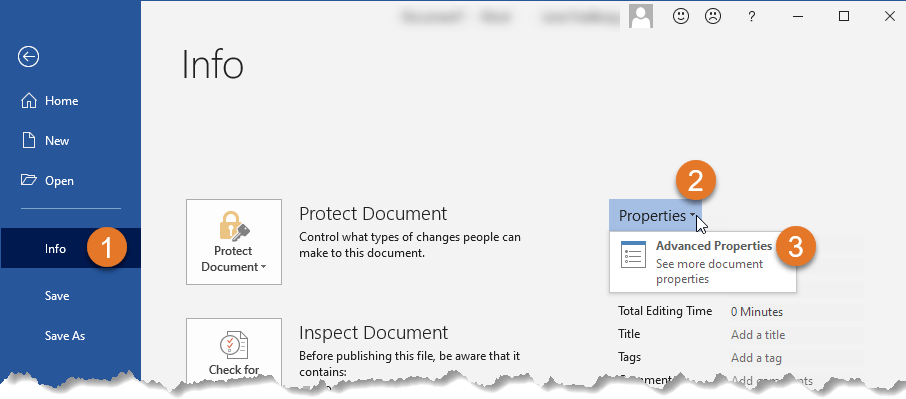
How to find Advanced Properties in Word.
Word 2007
Select Office button > Prepare (left side of dialog box) > in the Document Information Panel that opens below the Ribbon in Word, click the Properties drop-down > select Advanced Properties.
TIP: You can add the Properties dialog box to the Quick Access Toolbar (QAT) for easier access. The name of the command to find in the Word Options dialog box is Advanced Document Properties. For help on how to add a command to the QAT, see How to add a command or macro to the Quick Access Toolbar.
Note that DocTools DocPropertyManager provides easy access to the Properties dialog box in case you need to edit standard document properties.
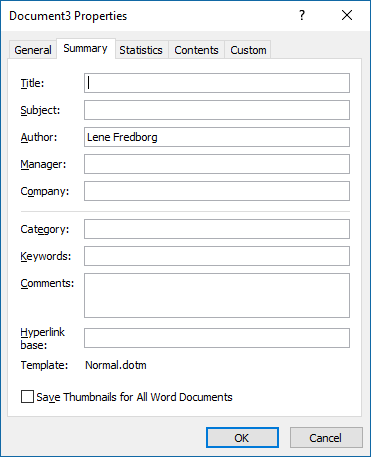
Example of the Properties dialog box showing properties for a new, blank document. The name of the document appears in the title bar of the dialog box, in this case "Document3".
As can be seen in the illustration to the left, the Properties dialog box has a number of tabs: General, Summary, Statistics, Contents, and Custom. All tabs except Custom are related to standard properties.
The Summary tab has fields that let you specify a value for each of the following standard properties:
Title
Subject
Author
Manager
Company
Category
Keywords
Comments
To edit the values:
- Type the values you want to assign to the individual properties. You may leave any of the fields empty.
- Click OK when finished.
How to add or edit custom document properties
How to add document properties in Word
The built-in functionality of Word lets you add custom document properties via the Properties dialog box.
- Open the Properties dialog box and select the Custom tab. See How to open the built-in Properties dialog box.
- Type a name in the Name field (up to 255 characters).
- Select a data type in the Type field (see About the different data types of custom document properties for details).
- Type a value in the Value field (up to 255 characters, however, the value must comply with the data type you selected).
- Click Add to add the property to the Properties list. If you are creating only one document property, you can skip this step. If you are going to add more document properties, repeat steps 2-5.
- Click OK when finished.
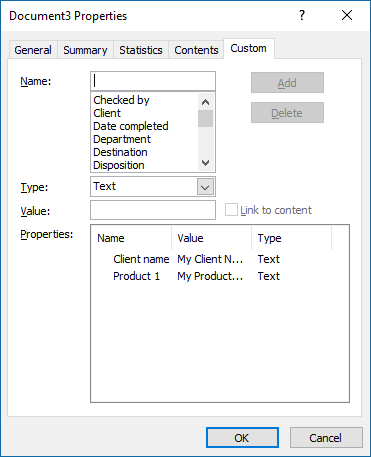
The Custom tab of the Properties dialog box lets you add custom document properties. In this example, two custom document properties have been added.
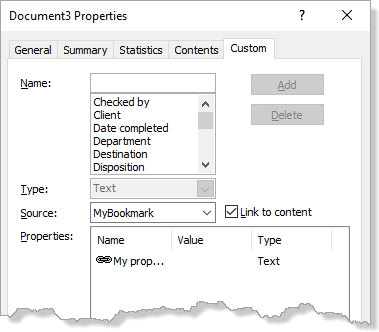
Example of property with Link to content turned on.
Below the Name list, you will find a number of suggested names you can select from, if relevant. The result is the same as typing the name directly in the Name field.
Word custom properties link to content
About the Link to content check box
Note the check box Link to content, next to the Value field. Custom document properties with Link to content turned on will show a link icon to the left of the name.
If you turn on Link to content, the label Value changes to Source and the field changes to a drop-down list. The drop-down list shows the names of all bookmarks in the document. Select a bookmark name from the list. If you insert a DocProperty field that refers to the custom document property in question, Word will (or rather: may...) insert the content of the bookmark. If the content of the bookmark is changed, the content of any DocProperty field referring to that bookmark should change too when fields are updated. But that only seems to happen if you, after the bookmark change, open the Properties dialog box and click OK – and then updated fields.
There are also other important limitations to the bookmark content shown in such DocProperty fields: Only plain text is included in the field result and only up to 255 characters no matter what is included in the bookmark. This means that you cannot use Link to content to have DocProperty fields show longer texts or non- textual content like images or tables.
Since it is doubtful how safe and/or useful it is to use this Link to content option, the DocTools DocPropertyManager add-in does not let you add custom document properties with this option turned on. If a document contains custom document properties added via the built-in Properties dialog box and if Link to content is turned on, DocTools DocPropertyManager will detect this in case you attempt to modify the property. You will then be asked whether you want to modify the property via the built-in dialog box instead.
The built-in Properties dialog box cannot be resized. This makes it impossible to see the full names and/or full values in many cases.
The dialog box for creating and editing custom document properties in the DocTools DocPropertyManager add-in is flexible and has room for longer names and values. In addition, it lets you sort the properties alphabetically. Also, a Filter field makes it fast to find a specific property in the list. When you click a property in the list, you will see information about how many DocProperty fields are found in the document that refer to that property.
How to edit document properties in Word
You could as well ask: How to modify document properties in Word. The terms edit and modify mean the same in this situation. You can edit (modify) the value of a custom document property.
- Open the Properties dialog box and select the Custom tab. See How to open the built-in Properties dialog box.
- In the Properties list, select the relevant document property.
- In the Value field, edit the value.
- If you are going to add or edit (modify) more document properties now, click Modify, else click OK.
- If one or more DocProperty fields in the document refer to the modified property/properties, update fields (Ctrl+A to select all, F9 to update fields).
How to rename custom document properties in Word
The built-in functionality in Word does not let you change the name of a custom document property. The DocTools DocPropertyManager add-in lets you easily rename custom document properties.
Once you have added a custom document property, you can edit its value but you cannot change the name using Word's built-in features. The only way to change the name of a custom document property is to delete the old property and add a new one. IMPORTANT: In addition, you will need to change the field code of any DocProperty field that refers to the custom document property in question. Otherwise, such field will show Error! Unknown document property name once fields have been updated.
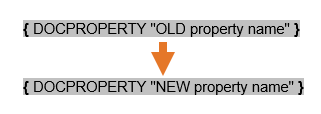
If you use Word's built- in feature, you must change the field code in DocProperty fields if you have deleted an old document property and added a new one to change the name.
As opposed to the cumbersome procedure needed for renaming a custom document property using Word's own features, the DocTools DocPropertyManager add-in lets you rename any existing custom document property simply by changing its name. DocTools DocPropertyManager will automatically do all the work for you, including correcting the field code in any DocProperty field that refers to the renames document property.
How to insert document properties in Word
To insert a document property in Word, you must insert a field of the type DocProperty. Using the built-in functionality, you can insert a DocProperty field either via the Field dialog box or by typing the field code manually. Both methods are described below. Note that the DocTools DocPropertyManager add-in makes it much faster and easier to insert DocProperty fields.
How to insert a DocProperty field using the Field dialog box
- In the document, click where you want the DocProperty field to be inserted.
- Select the Insert tab.
- in the Text group on the Ribbon, click the Quick Parts drop-down and select Field to open the Field dialog box.
- In the Categories list, select either (All) or Document Information,
- In the Field names list, select DocProperty.
- In the Property list, select the name of the document property whose value the DocProperty field is to show. See the illustration of the Field dialog box below.
The list includes both the standard properties and custom properties, if any. - Click OK to insert the DocProperty field.
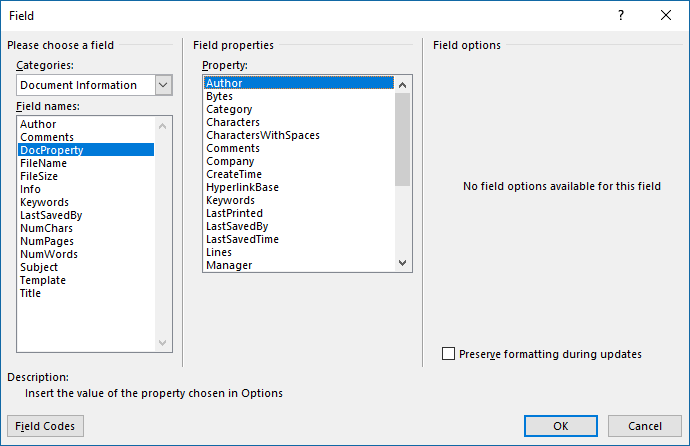
The Field dialog box ready for inserting a DocProperty field.
NOTE: By default, Preserve formatting during updates is turned on. If turned on, the MERGEFORMAT switch will be added to the field code. Personally, I always turn the option off since it may result in undesired formatting. For example, a field with the switch may appear with bold text if the field has once shown an error. If special formatting is desired, it is more stable to add relevant switches for the formatting directly.

DocProperty field showing field code and field result.
How to insert a DocProperty field by typing the field code manually
If you know the name of the document property you want to use, it is faster to type the field code manually than using the Field dialog box. The same is true for many other types of fields in Word.
- In the document, click where you want the DocProperty field to be inserted.
- Press Ctrl+F9 to insert a pair of field brackets (cannot be typed manually).
- Between the field brackets, type the following field code:
DOCPROPERTY "[name of property]"
where you replace [name of property] with the name of the desired property.
The use of uppercase and lowercase in the field code is without importance. If the property name consists of one word only, you may leave out the quotation marks. If the property name includes at least one space, you must add the quotes. Therefore, I recommend that you always add quotes for consistency. - Press F9 to update the field and turn off field codes.
If the field for some reason still shows field codes, press Alt+F9 to show the field result instead.
How to fix Error! Unknown document property name
If a DocProperty field refers to a property name that does not exist in the document, the field will show an error when fields are updated: Error! Unknown document property name. See the illustration below:
Example of DocProperty field showing an error because it refers to a property that does not exist. The error test will be shown in the language of your Word.
The error will occur if you have deleted the custom document property to which the field refers. The error will also occur if you insert content that has been copied from another document and if that content includes DocProperty fields that refer to property names that don't exist in the target document.
To fix the error, do one of the following:
- Add the missing custom document property and update fields. You can find the property name to use by checking the field code of the error field.
OR - Change the field code in the error field to match an existing custom document property. Then update the field.
OR - Delete the DocProperty field and edit the surrounding content as needed.
The DocTools DocPropertyManager add-in lets you easily add all missing custom document properties, if any, by the click of a button.
Are DocProperty fields updated automatically?
Note that DocProperty fields do not update automatically. If the value of one or more properties referred to in DocProperty fields has been changed, you need to update the fields to reflect the changes.
You can update DocProperty fields manually by selecting all (Ctrl+A) and pressing F9.
For detailed information about how all types of fields are updated, see my article Updating Fields in Word – How it Works.
Note that the DocTools DocPropertyManager add-in automatically updates DocProperty fields when needed.
About the different data types of custom document properties
As mentioned above, custom document properties can be of the types Text, Date, Number and Yes or No. Below, you will find a description of each type.
Text is the most commonly used type. The other types, Date, Number and Yes or no require specific values and in the document, such fields will not always insert a value that is identical to the value you specify in the Properties dialog box. Therefore, you must make sure that you fully understand how the values of those types work before you start using them.
I use custom document properties and DocProperty fields in the main part of the many Word documents I work with. I always define custom document properties of the type Text.
Type of custom document property
Description – how it works
Text
DocProperty fields that insert a Text property, inserts precisely the text you specify as the value of the property. Most often, you can use the type Text for all DocProperty fields. The value can include max. 255 characters.
The built-in functionality only lets you enter plain text as the value, without any paragraph breaks or manual line breaks. The DocTools DocPropertyManager add-in lets you add the following characters:
- nonbreaking spaces
- nonbreaking hyphens
- en dashes
- em dashes
- manual line breaks
- paragraph breaks
Date
You must enter a value in a date format that matches the definition in the regional settings on your PC.
You may need to experiment since the language settings also influence the way Date properties work.
In case of a standard Danish setting, you can, for example, use the syntax dd-mm-yyyy, e.g. 31-05-2019. A DocProperty field in the document may not always show the date as it appears in the value you specify. You may instead use the type Text. This way, you can enter the date value precisely as you want it to appear in the DocProperty fields in the document.
Number
You must specify a number, either an integer or a decimal number. The decimal symbol to use depends on the regional settings on your PC. If the decimal symbol is a period you can, e.g., enter 12345.678 as a value. A DocProperty field in the document will show the specified value. You may enter a number value with a thousands separator but Word ignores the separator in the field result.
Yes or No
You may enter the following:
* -1 (corresponds to yes) or 0 (corresponds to no) or
* True (corresponds to yes) or false (corresponds to no)
When you insert DocProperty fields, the value in the document will only be 'Y' for yes and 'N' for no.
How to manage document properties and DocProperty fields via macros (VBA)
Below, you will find VBA code examples showing:
These code samples may help you create useful macros. The DocTools DocPropertyManager add-in lets you do much more than that.
In order to create solid VBA code, you will need to add error handling to handle the types of errors that might occur. The code samples below do not include such error handling.
How to edit the values of standard document properties via VBA
Below are examples of VBA code to edit each of the standard document properties found on the Summary tab of the Properties dialog box.
By using names from the wdBuiltInProperty enumeration, you are sure to use correct names that will work in any language version of Word. Each property also has a number that can be used but your VBA code is much easier to understand if you use the names.
For a full list of the wdBuiltInProperty enumeration for Word, see https://docs.microsoft.com/en-us/office/vba/api/word.wdbuiltinproperty. Note the comments after each of the listed properties – some are not supported in Word even if they are in the list.
Examples of VBA code for editing the values of the standard properties in the active document found on the Summary tab of the Properties dialog box:
ActiveDocument.BuiltInDocumentProperties(wdPropertyTitle) = "My Title" ActiveDocument.BuiltInDocumentProperties(wdPropertySubject) = "My Subject" ActiveDocument.BuiltInDocumentProperties(wdPropertyAuthor) = "My Author" ActiveDocument.BuiltInDocumentProperties(wdPropertyManager) = "My Manager" ActiveDocument.BuiltInDocumentProperties(wdPropertyCompany) = "My Company" ActiveDocument.BuiltInDocumentProperties(wdPropertyCategory) = "My Category" ActiveDocument.BuiltInDocumentProperties(wdPropertyKeywords) = "My Keywords" ActiveDocument.BuiltInDocumentProperties(wdPropertyComments) = "My Comments"
If you are editing two or more values, you should use With and End With as shown below:
With ActiveDocument
.BuiltInDocumentProperties(wdPropertyTitle) = "My Title"
.BuiltInDocumentProperties(wdPropertySubject) = "My Subject"
.BuiltInDocumentProperties(wdPropertyAuthor) = "My Author"
End With
How to add a custom document property via VBA
The VBA code below adds a custom document property in the active document, with the name "My property", link to content turned off, type "Text" and value "My property value":
ActiveDocument.CustomDocumentProperties.Add _
name:="My property", _
LinkToContent:=False, _
Value:="My property value", _
Type:=msoPropertyTypeString
The Type can be one of the following:
- msoPropertyTypeString
Corresponds to the type Text in the Properties dialog box > Custom tab. - msoPropertyTypeDate
Corresponds to the type Date in the Properties dialog box > Custom tab. - msoPropertyTypeNumber or msoPropertyTypeFloat
Corresponds to the type Number in the Properties dialog box > Custom tab.
In case of a decimal number value, the type must be msoPropertyTypeFloat. The decimal symbol must match the decimal symbol defined in regional settings.
In case of an integer value, the type must be msoPropertyTypeNumber. - msoPropertyTypeBoolean
Corresponds to the type Yes or no in the Properties dialog box > Custom tab.
For more details about the data types, see About the different data types of custom document properties.
How to edit the value of a custom document property via VBA
The VBA code below changes the value of a custom document property named "My property" to "My new property value":
ActiveDocument.CustomDocumentProperties("My property").Value = "My new property value"
The VBA code also works if you leave out ".Value" since .Value is the default property. However, I recommend always adding the property. It makes the code easy to read and you don't run into problems. The example below has left out the default property .Value (not recommended even if it works):
ActiveDocument.CustomDocumentProperties("My property") = "My new property value"
The new value you assign must match the type of custom document property. For example, you can only assign the value in the example above if the type of custom document property is Text. If you assign a value that does not match the type, a run-time error occurs, saying "Type mismatch".
How to insert a DocProperty field via VBA
The VBA code below inserts a DocProperty field at the selection, referring to a custom document property named "My property". If no document property with the specified name exists, the field will show an error.
If you want the MERGEFORMAT switch to be turned on for the field, change PreserveFormatting from False to True.
The double quotation marks around "My property" are needed to have quotation marks added in the field code. There are other ways of adding the quotation marks, e.g. using the character code Chr(34). You could then replace ""My property"" with this instead:
Chr(34) & "My property" & Chr(34)
Selection.Fields.Add _
Range:=Selection.Range, _
Type:=wdFieldEmpty, _
Text:="DOCPROPERTY ""My property"" ", _
PreserveFormatting:=False
The field code of the inserted field will look like this:
{ DOCPROPERTY "My property" }
The field result depends on the value of the property named "My property".
How to handle both built-in and custom document properties in the same VBA code
If you want to be able to handle both built-in properties and custom document properties using the same macros/VBA code, see How to use a single VBA procedure to read or write both custom and built-in Document Properties.
How to find information about the field switches
In the general help on Word, you can find information about the different types of switches that can be used with specific fields.
The fastest way to find this information is often to search using your preferred browser. You can search for "field codes [TYPE OF FIELD] field" (example: "field codes docproperty field") or something similar.
More tips about working with fields in Word
Turn on field shading so you can distinguish fields from other content
In documents with fields, it is important to be able to distinguish fields from normal text so you don't accidentally change a field result by manually modifying its result. If you manually modify a field result, the change will disappear the next time the field is updated unless the field has been locked.
Therefore, I recommend that you set the Word option for Field shading to Always (File > Options > Advanced > Show document content group > Field shading > Always). With field shading on, all fields are shown with gray shading on the screen. The gray shading is only visible on the screen in Word – it does not print and it is not visible in PDF.
Information about how different types of fields are updated
For detailed information about how all types of fields are updated, see my article Updating Fields in Word – How it Works.
Useful shortcuts related to fields in Word
For information about keyboard shortcuts related to fields, see my article Word Fields – Useful Keyboard Shortcuts.
Did you know that...
DocTools Word Add-Ins
can help you save time and work more efficiently in Word
Generate complete documents in seconds from re-usable text or graphics
Manage comments in Word fast and easy – review comments, extract comments to Word or Excel, etc.
Simplify and speed up the management of cross-references even in your most complex documents
Manage and repeat data in Word fast and easy with custom document properties and DocProperty fields
Extract insertions, deletions and comments from any Word document, incl. context and headings
Apply any highlight color or remove highlight in Word with a single click – customizable shortcuts
Browse pages, sections, headings, tables, graphics, etc. and find text in Word with a single click
Check safety-critical procedure documents for human factor issues in minutes – improve quality and help prevent errors
Create screen tips in Word fast and easy – with up to 2040 characters
Once you understand how custom document properties and DocProperty fields in Word work, you will be able to create Word documents more efficiently. If you use custom document properties and DocProperty fields for metadata and repeated data, if is easier for you to keep the document data updated and correct.
This article has explained how to add document properties in Word, how to edit document properties in Word, how to insert document properties using DocProperty fields, etc. I hope this article helps you in your future work with custom document properties and DocProperty fields in Word.


